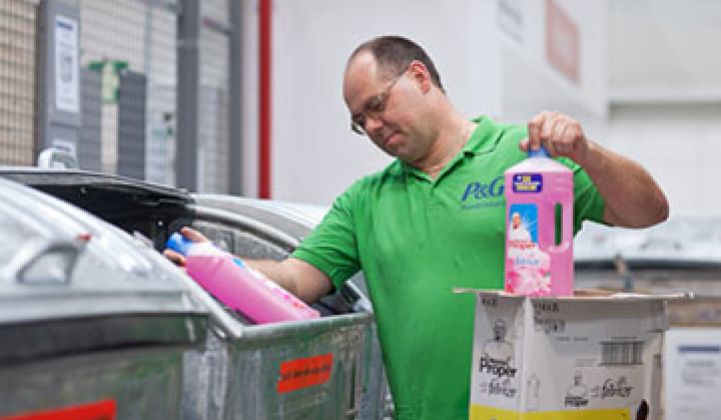When you unfurl a roll of Charmin toilet tissue, you can rest assured that the waste created to make that product is being used for a useful cause: inexpensive roof tiles for homes in Mexico.
The same goes when you shave your face or wipe your newborn baby's bottom: Turns out, the waste products from Gillette shaving foam are composted to grow turf for commercial facilities, while the scrap from Pampers is turned into upholstery filling.
This is what a zero-waste strategy looks like.
"It's not rocket science, and it's not a huge leap of imagination," said Forbes McDougall, product supply waste team leader at Procter & Gamble (P&G), in an interview. "But it can get pretty challenging technically after the easy stuff is addressed."
P&G announced this week that it had achieved zero waste at 25 percent of its manufacturing facilities -- a strategy that has created $1 billion in value over the last five years. In 2007, a P&G facility in Budapest became the first to recycle all its waste products. Three years later, seven more sites achieved that target.
"Then we started hitting critical mass," said McDougall. Once the concept had been proven, more production plants joined on.
In 2012, P&G converted another nineteen production sites, bringing the company's portfolio of zero-waste facilities to 45. It has a dozen more closing in on the goal this fiscal year.
So is this true corporate sustainability?
There are a lot of harsh criticisms of fluffy greenwashing campaigns on the part of large corporations. P&G has been lampooned for its animal testing, for calling its chemical products "eco-friendly" without any evidence to back it up, and for thinking its campaign to encourage tap water over bottled water constituted a true corporate commitment to environmentalism.
However, the company tried to change that perception in 2011 by creating a sustainability plan to use 100 percent recycled packaging, cut out all its landfill waste, and power its facilities with 100 percent renewable energy by 2020. The company has started installing on-site solar, purchasing more renewable electricity, and has converted 25 percent of its production plants into zero-waste facilities.
McDougall says the corporate sustainability targets played a big role in encouraging plant managers to recycle all their waste.
"We could go to the plant managers and use those goals as a way to frame the conversation," said McDougall. "The work was going to get done one way or another. This more strategic global approach, where you have experts looking at the problem in partnership with managers onsite, has really driven things forward."
After McDougall's small group of purchasing managers proved the concept worked, the corporation took them seriously and grew them into a global team. According to P&G, the company now recycles 99 percent of its waste products globally.
But going into a facility and dealing with that last 5 percent or 1 percent of waste can be extremely difficult. For example, very diluted chemical products for cleaning the manufacturing lines aren't easily converted into a usable product.
"We've got tons of waste streams, some much more challenging [to reuse] from a technical point of view. But we don't want to be paying to dispose of material we are buying in the first place, so we find ways to make it work," said McDougall. "And now that we're getting better at it, we can integrate this into new facilities before they're built."
Although P&G has taken hits for its corporate sustainability claims in the past, this zero-waste strategy is creating real and verifiable change within the company. And with $1 billion in new revenue and saved landfill costs, it's also created major financial value in the process.



